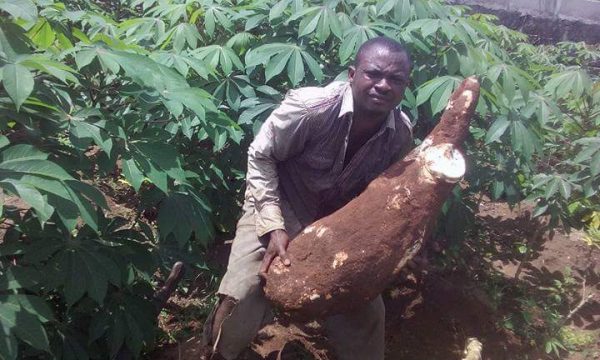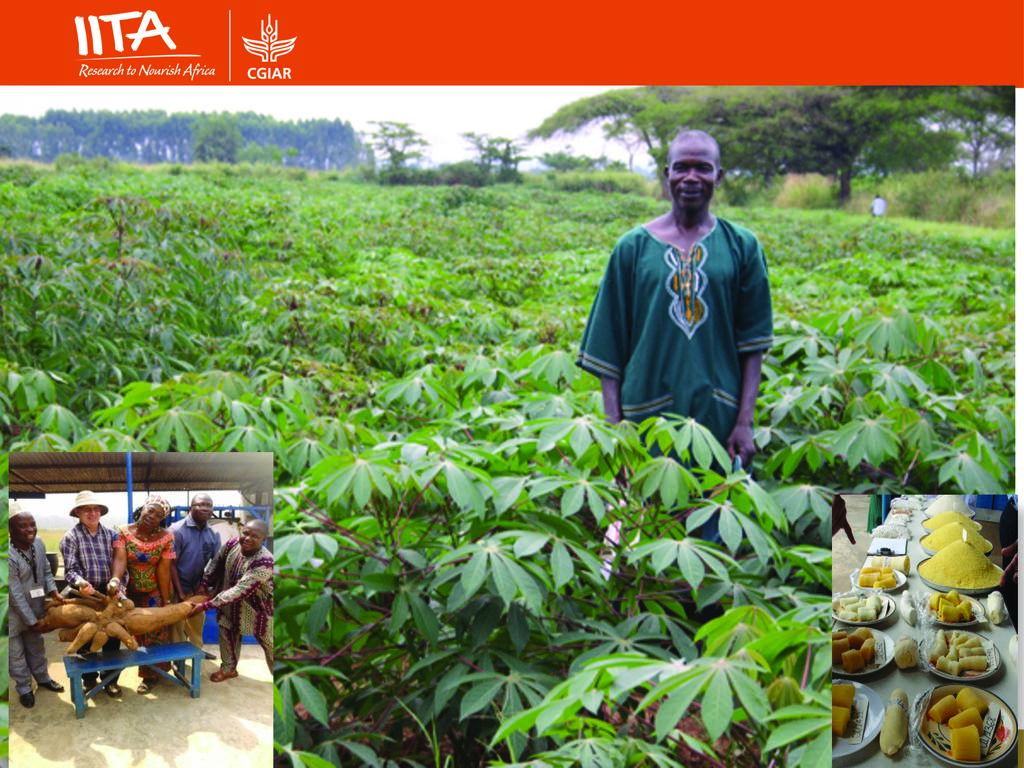Cassava cultivation in nigeria pdf
that the use of fertiliser in cassava production is much lower than in any of the other major food crops in Nigeria. Further development of the cassava sub sector in Nigeria will have to contend with the intractable problem of fertiliser supply distortions. Pests and diseases. Various diseases and insect pests plague cassava and result in huge economic losses. These include the cassava mosaic
SOCIO-ECONOMIC ASPECTS OF CASSAVA CULTIVATION IN NIGERIA: A CASE STUDY OF ESAN AREA OF EDO STATE Dr. Samson I. Omofonmwan Abstract Garri – one of the products of cassava tuber, is the commonest and cheapest
growing and processing cassava or lack the ability to use them. There is also paucity of cassava production specialists, agribusiness experts, processing and, agro-machinery experts to provide advice to
Nigeria is currently the largest producer of cassava in the World with annual production of over 34 million tonnes of tuberous roots. Both rich and the poor farmers prefer to sell high
Cassava is one of the most popular crops being grown by the arable farmers in southwestern Nigeria (Ogbe, et al. 2007). Ondo state is known to be one of the most
Determinants of Climate Change on Cassava Production in Oyo State, Nigeria . By Ayoade A.R. Ladoke Akintola University of Technology, Ogbomoso, Oyo State Abstract – The study examined the determinants of climate change on cassava production in the study area. To achieve this main objective, the study identified the socio economic characteristics of the cassava farmers; identified …
showed that in both Ghana and Nigeria, cassava cash incomes were the highest in farms . with access to mechanized cassava processing equipment for the preparation of gari. The . contribution of
In 2007, global production capacity of cassava amounted to 228.14 million tons. Thailand was by far the third largest producer at 26 million tons, following the lead by Nigeria and Brazil.
Growing cassava: A training manual from production to postharvest. IITA, Ibadan, Nigeria. GROWING CASSAVA A training manual from production to postharvest Adebayo B. Abass, Elifatio Towo, Ivor Mukuka, Richardson Okechukwu, Roger Ranaivoson, Gbassey Tarawali and Edward Kanju. Content 1 Cassava stem handling for increased yield 2 Background Preparing healthy cassava stems for …
Harvesting and Yield in Cassava Cultivation:- The cassava crop is ready after 10 to 12 months of planting and short duration crops may be ready in 6 to 7 months after planting. Harvesting in right time is more important as delay may result in low quality of tubers..
affecting cassava production in Ebonyi State Nigeria. From Table 2 it was observed that the R2 of 0.669, about 67% of included female factor challenges were explained as providing the best fit as the factor challenges affecting cassava production in Ebonyi State. Specifically, the income level of women, the poor entrepreneurial attitude of women, and their poor access to technology and
PDF Nigeria’s biofuels policy advocates the adoption of cassava as feedstock for a 10%-biofuel substitution option in Nigerian transport fuel demand. This policy option is expected to address
Local varieties of cassava conservation cultivation and
https://youtube.com/watch?v=MhMGSmDNV0I

The adoption of improved cassava varieties and their
the African continent with Nigeria being the world’s largest producer of Cassava. Cassava is also called Tapioca in its powdered form. With Regards to India, Cassava has been in cultivation since the 1960s and is majorly grown in southern India2 in the states of Kerala, Tamil Nadu and Andhra Pradesh. We have found that there are 3 specific areas illustrated as below where significant
ECONOMICS OF CASSAVA CULTIVATION AND ITS COMPETING CROPS IN IBADAN METROPOLIS, OYO STATE, NIGERIA O.O. Olayiwola Research Scholar, Development Policy Centre (DPC), Ibadan, Nigeria Email: olubodun_2008@yahoo.com ABSTRACT Cost studies are backbone in the field of research in agricultural economics which is quite evident of the fact that all systematic …
producing new leaves when rains resume. Cassava does not tolerate freezing conditions, but does tolerate a wide range of soil pH 4.0 to 8.0 and is most
Production of cassava, yams, and cocoyams has increased by roughly 50%, 30%, and 60%, respectively, due mainly to increases in their seeded area.
The contributions of all the participants of the Nigeria Cassava Monitoring Convening Workshop organized, 15–21 March, 2015 by BMGF in Dar es Salam, Tanzania are gratefully acknowledged.
Gender disparity in cassava production in Ughelli South Local Government Area of Delta State Nigeria Bishop O Ovwigho1 ‘and ‘ PA Ifie2 1 Department of Agricultural Economics and Extension Delta State University Asaba Campus Asaba Delta State Nigeria
Cassava grows poorly in clayey and stony soils. Step1. Select a good site Cassava is grown in all agro-ecological zones in Nigeria. It grows poorly in clayey and stony soils.
Production of Adhesive from Cassava Starch in Owerri, Imo State, Nigeria Ihenetu Stanley Chukwuemeka, Igbokwe Winner Ugochukwu Department of Chemistry, Imo State University Owerri, Imo State, Nigeria E-mail address: astancos41@gmail.com ABSTRACT The potentials of adhesives production from cassava starch were investigated. Adhesive product from Manihot utilissima was …
The beginning of cassava cultivation along the coastal parts of Nigeria has been recognized as early as 1667 and is traceable to Portuguese explorers and emancipated slaves from Brazil and the West Indies who had landed on the southern coast of Nigeria between the Bonny and Koko ports. Thus, cassava
Cassava (Manihot esculenta Crantz) is the most important source of calories in the tropics after rice and maize [1] and forms a major part of the diet for nearly a billion people in approximately

This study determined the socio-economic factors and problems influencing cassava production in Taraba state, Nigeria. Data were collected from 115 respondents using a structured questionnaire covering 2010/2011 farming season. The data were analyzed using descriptive However, cassava production have some constraints, prominent among which are; inadequate finance accounting for …
increases in production in 2012 in Ghana, Nigeria, and Tanzania, with a possible decline in production in Uganda due to cassava mosaic virus. From 2009 to 2012, Africa is forecast to increase production by an average of 7.6%
How to cite this article: Onyemekonwu RC, Igene CA, Ehiwario FA . Assessment of the Extent of Incorporating Indigenous Knowledge Systems in Extension Programming for Cassava Cultivation in Delta State, Nigeria.
Assessment of the Extent of Incorporating Indigenous
Cassava is one of the mostly cultivated root crops in Nigeria, and in Ekiti State with specific reference to this study. This study examined the cost and returns analysis of cassava production in Ekiti State.
government policy on cassava development will soon or later make Nigeria discover an ideal cassava for the 21st century to enable her feed her growing population and has reserves for export and security.
PDF Abstract KEY WORDS: Germplasm, cultivars, linamarin Cassava, (Manihot esculenta C.,) is believed to have been introduced into Nigeria in the early 1550 by Portuguese traders. Although
Variables investigated included farmer preferences for cassava cultivation, utilization and cassava conservation practices as well as cassava local varieties cultivated by farmers. Varieties were recorded as named by farmers in their native languages of the different ethnic groups in …
GROWING CASSAVA iita.org
288 AGRONOMIC PRACTICES FOR SUSTAINABLE CASSAVA PRODUCTION IN ASIA Reinhardt H. Howeler1 ABSTRACT The paper describes research results obtained in …
Cassava production utilization and marketing – a case

(PDF) Cassava cultivation in sub-Saharan Africa
https://youtube.com/watch?v=OMwrFM7qIDk
Economic Efficiency of Cassava Based Farmers in Southern
ECONOMICS OF CASSAVA CULTIVATION AND ITS COMPETING
SOCIO-ECONOMIC ASPECTS OF CASSAVA CULTIVATION IN NIGERIA


EFFECT OF CLIMATIC VARIABLES ON CASSAVA FARMERS PRODUCTION
(PDF) Cassava Cultivation as Panacea to Poverty reduction
Analysis of Sustainable Cassava Biofuel Production in Nigeria

Cassava Production and Gender Factor Challenges Affecting
https://youtube.com/watch?v=W4qTxKdjagg
Cassava Cultivation Insights from India
The adoption of improved cassava varieties and their
ECONOMICS OF CASSAVA CULTIVATION AND ITS COMPETING
In 2007, global production capacity of cassava amounted to 228.14 million tons. Thailand was by far the third largest producer at 26 million tons, following the lead by Nigeria and Brazil.
PDF Nigeria’s biofuels policy advocates the adoption of cassava as feedstock for a 10%-biofuel substitution option in Nigerian transport fuel demand. This policy option is expected to address
Cassava is one of the mostly cultivated root crops in Nigeria, and in Ekiti State with specific reference to this study. This study examined the cost and returns analysis of cassava production in Ekiti State.
Harvesting and Yield in Cassava Cultivation:- The cassava crop is ready after 10 to 12 months of planting and short duration crops may be ready in 6 to 7 months after planting. Harvesting in right time is more important as delay may result in low quality of tubers..
increases in production in 2012 in Ghana, Nigeria, and Tanzania, with a possible decline in production in Uganda due to cassava mosaic virus. From 2009 to 2012, Africa is forecast to increase production by an average of 7.6%
affecting cassava production in Ebonyi State Nigeria. From Table 2 it was observed that the R2 of 0.669, about 67% of included female factor challenges were explained as providing the best fit as the factor challenges affecting cassava production in Ebonyi State. Specifically, the income level of women, the poor entrepreneurial attitude of women, and their poor access to technology and
Production of cassava, yams, and cocoyams has increased by roughly 50%, 30%, and 60%, respectively, due mainly to increases in their seeded area.
SOCIO-ECONOMIC ASPECTS OF CASSAVA CULTIVATION IN NIGERIA: A CASE STUDY OF ESAN AREA OF EDO STATE Dr. Samson I. Omofonmwan Abstract Garri – one of the products of cassava tuber, is the commonest and cheapest
Production of Adhesive from Cassava Starch in Owerri, Imo State, Nigeria Ihenetu Stanley Chukwuemeka, Igbokwe Winner Ugochukwu Department of Chemistry, Imo State University Owerri, Imo State, Nigeria E-mail address: astancos41@gmail.com ABSTRACT The potentials of adhesives production from cassava starch were investigated. Adhesive product from Manihot utilissima was …
ECONOMICS OF CASSAVA CULTIVATION AND ITS COMPETING CROPS IN IBADAN METROPOLIS, OYO STATE, NIGERIA O.O. Olayiwola Research Scholar, Development Policy Centre (DPC), Ibadan, Nigeria Email: olubodun_2008@yahoo.com ABSTRACT Cost studies are backbone in the field of research in agricultural economics which is quite evident of the fact that all systematic …
The beginning of cassava cultivation along the coastal parts of Nigeria has been recognized as early as 1667 and is traceable to Portuguese explorers and emancipated slaves from Brazil and the West Indies who had landed on the southern coast of Nigeria between the Bonny and Koko ports. Thus, cassava
The contributions of all the participants of the Nigeria Cassava Monitoring Convening Workshop organized, 15–21 March, 2015 by BMGF in Dar es Salam, Tanzania are gratefully acknowledged.
growing and processing cassava or lack the ability to use them. There is also paucity of cassava production specialists, agribusiness experts, processing and, agro-machinery experts to provide advice to
Determinants of Climate Change on Cassava Production in Oyo State, Nigeria . By Ayoade A.R. Ladoke Akintola University of Technology, Ogbomoso, Oyo State Abstract – The study examined the determinants of climate change on cassava production in the study area. To achieve this main objective, the study identified the socio economic characteristics of the cassava farmers; identified …
Nigeria is currently the largest producer of cassava in the World with annual production of over 34 million tonnes of tuberous roots. Both rich and the poor farmers prefer to sell high
